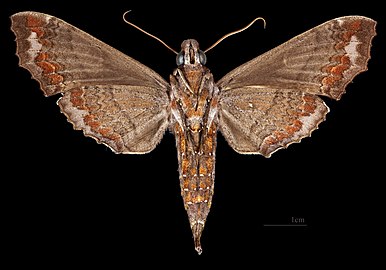| Hemeroplanes ornatus | |
|---|---|

| |
| Scientific classification | |
| Domain: | Eukaryota |
| Kingdom: | Animalia |
| Phylum: | Arthropoda |
| Class: | Insecta |
| Order: | Lepidoptera |
| Family: | Sphingidae |
| Genus: | Hemeroplanes |
| Species: | H. ornatus |
| Binomial name | |
| Hemeroplanes ornatus Rothschild, 1894 | |
| Synonyms | |
| |
Hemeroplanes ornatus is a species of sphinx moth native from Mexico through northern South America. The species was first described by Walter Rothschild in 1894.
Description
H. ornatus is mainly light brownish gray with green, pink, and dark brown markings. In the forewing cell, there is a short silver mark. There is a greenish-brown stripe running the length of the abdomen, with three yellow lateral stripes on the second, third, and fourth segments.
Life cycle
The female releases pheromones to attract males. The caterpillar is green, camouflaged against its host plant Fischeria panamensis. However, when disturbed, the caterpillar hangs from the vine with his prolegs and puffs up its head and thorax. The underside of its body is brown, and it has a pair of false eyes on the thorax, making it look like a small snake. It will move back and forth and strike at predators.
References
- "CATE Creating a Taxonomic eScience - Sphingidae". Cate-sphingidae.org. Archived from the original on 2012-11-10. Retrieved 2011-10-19.
- ^ Bill Oehlke. "Hemeroplanes ornatus". Archived from the original on 27 August 2011. Retrieved 20 October 2010.
- Rothschild, Lionel Walter (1894). Novitates Zoologicae (1 ed.). British Museum (Natural History). p. 74. Retrieved 21 October 2010.
- ^ Ricklefs, Robert E.; Miller, Gary Leon (2000). Ecology (4 ed.). New York, NY: W. H. Freeman and Company. p. 124. ISBN 0-7167-2829-X. Retrieved 21 October 2010.
- Sullivan, Evelin (2001). The Concise Book of Lying. New York, NY: Picador. p. 278. ISBN 0-312-42047-1. Retrieved 21 October 2010.
| Taxon identifiers | |
|---|---|
| Hemeroplanes ornatus |
|
This Dilophonotini-related article is a stub. You can help Misplaced Pages by expanding it. |



